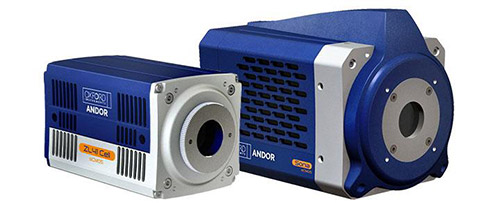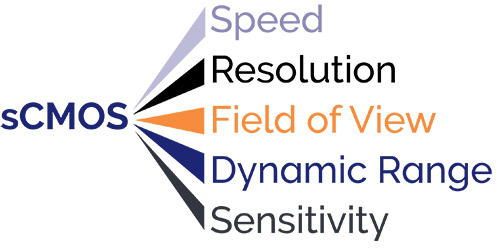Resources
 Part of the Oxford Instruments Group
Part of the Oxford Instruments Group
Expand
Collapse
 Part of the Oxford Instruments Group
Part of the Oxford Instruments Group
Scientific CMOS, or sCMOS, is a state-of-the-art scientific imaging sensor technology for life sciences and physical sciences from quantum optics and solar astronomy to developmental biology. sCMOS offers performance features that make it perfect for quantitative scientific measurement and it produces exceptional scientific images. Its development has brought many innovations in the production and operation of the sensor, from its physics and electronics, to the software developments for processing and analysing images.

Developmental Biology
Plasma Membrane
Intercellular Trafficking
Organoids
Gene Editing
Neurophysiology
Neo and Space Debris
Adaptive Optics
Fluid Dynamics
Dynamic X-Ray Imaging
Neutron Radiography and Tomography
Cold Atoms and Bose
Einstein Condensation
Quantum Optics
Solar Astronomy

sCMOS technology overcomes the trade-offs that are associated with conventional CMOS cameras. Unlike previous generations of CMOS and CCD-based sensors, sCMOS offers:
The sensor offers a large field of view and high resolution, without compromising read noise, dynamic range or frame rate.
sCMOS read noise is exceptionally low, even when compared to the highest performance ‘slow-scan’ CCDs. The low noise readout is complemented by up to 53,000:1 dynamic range. For a comparison of the main features see the table.
| Parameter | ZL41 5.5 sCMOS | Sona-6 sCMOS | Interline CCD | EMCCD |
| Sensor Format | 5.5 megapixel | 4.2 megapixel | 1.4 to 4 megapixel | 0.25 to 1 megapixel |
| Pixel Size | 6.5 μm | 6.5 μm | 6.45 to 7.4 μm | 8 to 16 μm* |
| Read Noise | 1.2e- @ 30 frames/sec 1.45e- @ 100 frames/sec |
<1.0e- @ 43 frames/sec 1.9e- @ 135 frames/sec |
4 - 10 e- | < 1 e- (with EM gain) |
| Full Frame Rate (max.) | 100 frames/sec @ full resolution | 135 frames/sec @ full resolution | 3 to 16 frames/sec | ~ 30 frames/sec |
| Quantum Efficiency (max.) | <64% (front illuminated) | <95% (back-illuminated) | <60% | <95% (back-illuminated) |
| Dynamic Range | 33,000:1 | 26,250:1 |
~ 3,000:1
(@ 11 frames/sec)
|
8,500:1
(@ 30 frames/sec with low EM gain)
|
| Multiplicative Noise | None | None | None |
1.41x with EM gain
(effectively halves the QE)
|
* Most EMCCD sensors feature large 13-16 µm pixel sizes that prioritise photon collection efficiency over resolution.
sCMOS has dual amplifiers and dual analogue-to-digital converter readout which leads to high dynamic range. A low gain channel and a high gain channel are read simultaneously, and the information combined. This produces an exceptional dynamic range. As you can clearly see in the image, Interline CCD cannot compete (see table and image). The unique dual amplifier architecture of sCMOS allows for high dynamic range alongside lowest noise.

Andor’s ZL41 5.5 sCMOS offers ‘rolling’ and ‘global shutter’ modes. Global shutter mode is where all pixels are exposed at the same time. It avoids the image distortion caused when physical shutters sequentially expose the sensor. Read more in our article about rolling and global shutter.
Pixel columns are calibrated for differences in signal. And individual pixels are corrected for non-uniformity in signals. There is a blemish correction for faulty pixels and a spurious noise filter particularly relevant for low light conditions. It is also possible to use a Region of Interest, to increase the frame rate on interesting rows.
Download our product Specification Sheets for ZL41, iStar, Sona, Marana and Balor to find out more details and to see example images and applications.

Date: December 2022
Author: Dr. Jo Walters & Dr. Alan Mullan
Category: Application Note
